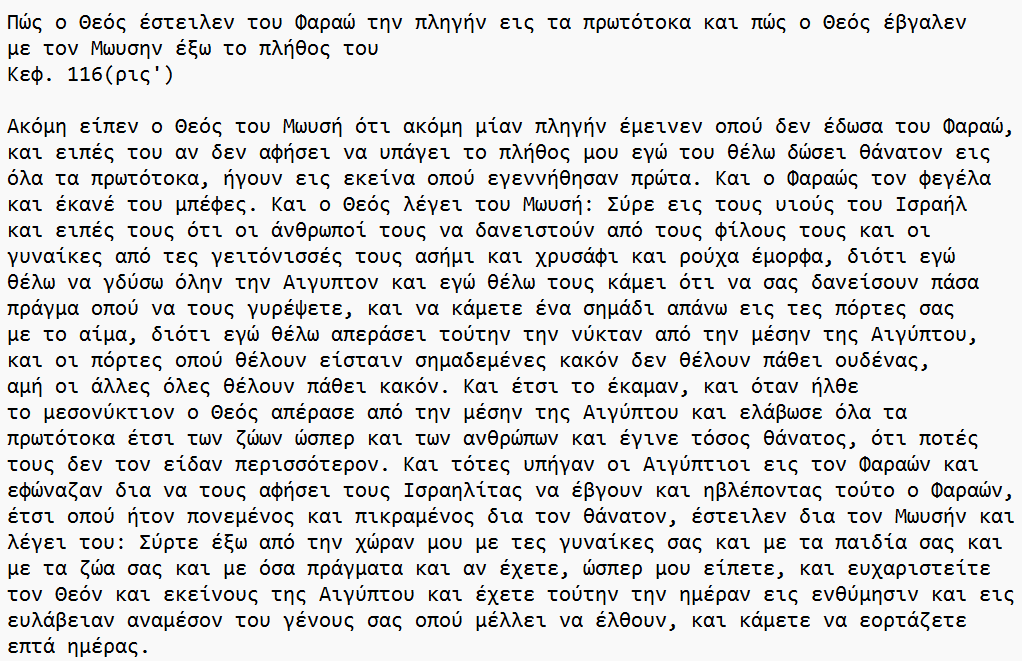From the Greek Middle Ages to CLARIN:EL
On the occasion of the bloody events that unfolded in reaction to the translation into demotic of the Gospels (8 November 1901) and the Oresteia trilogy (9 November 1903)1, this month is dedicated to the resources which are hosted in the CLARIN:EL Infrastructure representing an older form of the Greek language and constitute members of the Medieval and Early Modern Greek Resource Family.
Eleni Karantzola, Associate Professor of Linguistics with specialization in the History of the Greek Language and Language Policy at the Mediterranean Studies Department of the University of the Aegean, talks about the resource Old and New Testament.
"This is the first attempt to transliterate passages of the Old and New Testaments into the Greek language, by the Corfiot Ioannikios Kartanos. The work was published in Venice in 1536, a century before their official translation, during the patriarchate of Cyril Lucan, by Maximos Kallioupolitis (Geneva, 1638). Kartanos' translation is part of a wider spiritual movement to render sacred texts in vernacular languages so that believers (religious people) can have an unmediated relationship with the divine, following the urgent demand of the Reformed churches. These developments in the religious field have in turn contributed decisively to the more general phenomenon that has been called the 'first ecolinguistic revolution' (Baggioni 1997), which refers to the use of vernacular languages in the written word, with the parallel retreat of the 'sacred' languages (ancient Greek, classical Latin, biblical Hebrew).
As far as Greek is concerned, examples of the use of vernacular language (i.e. a written variety quite close to the colloquial ones) can be found as early as the medieval period. However, we will have to wait until the turn of the 16th century to see prose texts in demotic multiply exponentially and cover a very wide literary range. This important development for the history of Greek language and literature is mapped in the volume Demos prose of the 16th century by E. Kakoulidis-Panos, E. Karantzola and K. Tiktopoulou, the product of a long-term research project initiated by the Centre for the Greek Language and published in the summer of this year by the National Bank of Greece Cultural Foundation.
Among the resources that have been published through the CLARIN:EL Infrastructure are: a) bibliographical records (in pdf format) concerning Medieval and Early Modern Greek, which formed the basis for the compilation of the Kriaras Lexicon and of Emm. Kriaras, b) two extensive prose narrative texts of the 16th century (in word), the Old and New Testament by I. Kartanos and "The Bed of Solomon" by I. Morezinos, c) 11 complete notarial registers (=books of notarial deeds) of the 16th century of notaries from Crete and Corfu."
1 The bloody incidents that took place in Athens on November 8, 1901, on the occasion of the publication in serial form (9/9/1901-20/10/1901) by the newspaper Acropolis of the Gospels dubbed into the vernacular by Alexandros Pallis, have been recorded as "Evangelicals", or Evangelicals. The 'Oresteia' are a blurred repetition of the Evangelion(s) and refer to the incidents that broke out in Athens between 16 and 19 November 1903, by motivated students, in reaction to the translation of Aeschylus' trilogy Oresteia for performances at the Royal Theatre.

Eleni Karantzola
Associate Professor of Linguistics
Mediterranean Studies Department, University of the Aegean
Resource information
Greek
Preview


